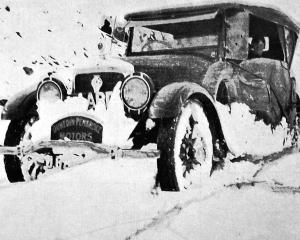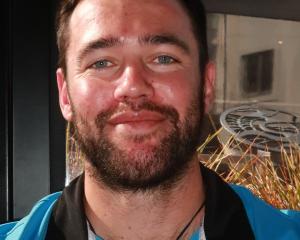
A toxic algae bloom is creeping up Otago Harbour, smothering everything in its path.
Do you race down to the harbour to see it for yourself or shrug it off as just one of those things?
Kerikeri writer Dr Octavia Cade is fascinated by the ways people could react to the scenario and interact with the environment.
"So there’s this plethora of strange and fascinating possible reactions."
So much so the scenario forms the basis for a science fiction novel and a research paper she is writing this year while the Robert Burns Fellow at the University of Otago.
"They’ve all gone a bit barmy, my characters. But it’s fun. If you’re into science fiction as I am, and you’ve been reading New Zealand science fiction from when you were a kid, there’s a surprising amount of it that really looks at what do we do with an invasive species once it gets to New Zealand."
Algae blooms are becoming more common in New Zealand summers with warming waters and nitrate run-off impacting waterways. It makes the perfect villain for Cade’s preferred "near-future" writing style.
"There are some really strange and interesting side effects [from it]."
Even Under the Mountain by Cade’s favourite author from childhood, Maurice Gee, has its invasive species.
"The invasive species there was obviously the Wilberforces. They horrified me as a child, but as I grew up, and I keep reading it, because I do read it on a fairly regular basis, the solution to it is pretty damn horrifying, if you think about it. The solution to ecological invasion in the Wilberforces is for children to commit genocide."
Cade grew up in Nelson and used to live across the road from the botanical gardens where Gee’s The World Around the Corner is set.
"So I would run up, well, I would play on the mountain pretending to be Caroline, who was the hero of that book."
Her love of science fiction developed in childhood thanks to her mother who made sure she and her sister watched Star Trek.
"So we’re both sci-fi fans from way back so when I started writing, it was going to be science ficition rather than anything else."
But it took time before Cade embraced writing as she planned to be a scientist. She came to Dunedin to study botany but soon discovered she "really hated" the way scientists were trained to write and the language of scientific papers.
"The idea behind this is that the writing is as efficient as possible and can be read by other scientists working in your field. The downside of that is that it blocks everyone else out."
As she was finishing her scientific studies, the Centre for Scientific Communication was starting up and gave her hope of another way.
"That was the genesis for the shift, the sheer disgust of the scientific paper. I think at the time I remember there was a bit of a kerfuffle, it was one of the national journals in sciences, and it was supposed to be revolutionary that they were moving in their methods from third person to first person. I thought, God, do I really want to be reading and writing this for the rest of my professional life?"
The move to science communication (the programme has since been cut) was an excellent move for Cade who has since completed her PhD in science communication and discovered she could turn her "fun" short-story writing hobby into something more.
Back then she was writing more generic science fiction featuring vampires and other more usual genre characters.
"But I wasn’t very good at writing them. It turned out what I was quite good at writing about was plants and animals and how people react with nature and how we talk about science. And so once I started writing, they say write what you know, and eventually I started listening."
It turned out to be good advice and her stories began to do well.
"So I started writing science fiction as a way to communicate science, basically. And it sort of took off from there. So yes, the scientific paper is responsible for my career writing novels about algal blooms."
After helping her marine biologist father as a child she knew marine biology was not as glamorous as it sounded.
"It was standing in freezing cold warehouses holding clipboards while he dissected fish. And so I thought, I don’t want anything to do with marine biology on any level."
But a compulsory marine botany paper turned out to be more interesting than she expected. And down the line it has ended up producing a story about algae blooms. She has discovered a real fascination for the blooms, imagining a bright red harbour and people going slowly "doolally" around it after injesting food affected by it.
"With algae, the colour and how toxic it is, how poisonous, how it smothers everything in the harbour. I mean, imagine an albatross trying to float in that or a seal. It sort of kills everything and you can’t go swimming. It affects all the water sources, it sort of spreads. It’s like this little contagion.
"And the fascinating thing about algae blooms is really we have a decent idea how to stop them. You know, we’ve got to control runoff and all sorts of things, but we often don’t."

"When I see something particularly weird or disgusting happening in the animal world, I "favourite" the page and then shove it in my story ideas file."
Her first novel The Stone Wētā, published in 2020 and expanded from a short story written in 2016, came about after she read how scientists during Donald Trump’s first term as United States president were working across borders to store climate data and information as they were concerned about censorship. The short story had been picked up by one of the top international science fiction publications Clarkesworld Magazine.
"I was thinking, well, this sounds like something people should be talking about more than they are. And so that’s where a lot of my stories come from, actual interesting bits of science. And I was able to include a lot of weird stuff in that book."
Still really liking the concept, Cade developed it into an adult novel and it won the Sir Julius Vogel Award for best novel.
Another news article she has bookmarked is of the fishscale gecko, which sheds its scales and "skitters off looking like raw chicken breast".
"The pictures of this thing are revolting and fascinating. And I just love that anything weird and disgusting that can be used as colour."
Cade believes each writer has their own natural length. Hers is short stories — she has had about 70 published to date around the world — so writing a novel is more of a challenge.
"It’s one of the advantages of the Burns. You get space to upskill in your creative practice."
She sees her short stories as being part of a long historical and cultural tradition of short story writing in New Zealand with New Zealand children growing up on authors like Katherine Mansfield, Janet Frame, Patricia Grace and Owen Marshall’s work.
"I just love them. I love how short stories require different things from readers and writers. You cannot, because you’ve got such a limited word count, you can’t go explaining everything. You can’t really go down sidetracks and wander. You’ve got to be very economical with your storytelling. And you have to trust that the reader can follow along. And I quite like that.
"Whenever I try to write a novel, I often feel like I’m putting in all this waffle. But you can’t write a novel like you’re writing a short story."
Cade remembers her first day in the Robert Burns fellow’s office sitting staring at her computer.
"For nearly the entire day, I stared sort of frozen in terror at this blank screen because they’d given me the opportunity and I’d been expected to produce something, something good."
She gave herself a good talking to that night and the next day began to write. But she still feels slightly intimiated by the list of top New Zealand writers that have gone before her.
"I have a bucket list, you see, of writing opportunities that I would like to apply for. And I’ve been quite lucky in getting them, but it is a luck that has been very much underpinned by a lot of hard work."
She has applied for the Burns fellowship and others many times before, seeing each application as practise developing her application skills and learning from the rejections and comments she receives.
"I mean, if you are in the creative sector, you have to have a very thick skin when it comes to rejection. A lot of it is luck, but a lot of it is hard work and not taking yourself too seriously. It’s never nice having a story rejection or a novel rejection or a residency rejection. But if you are going to work in this industry, you need to learn to suck it up. And it’s all part of the learning process, I suppose, in the end."
These days her other "hobby", academic writing, has also become more of a focus as she became aware that it is an advantage to have a list of academic papers to her name when applying for residencies.
"I don’t get paid for academic writing but there is a cachet there and it is an investment."
But it is also an excuse for her to indulge some of her passions such as a love of horror movies — a side effect of growing up on science fiction and her love of Under the Mountain.
"The terror I spent lying awake at night thinking about the Wilberforces, you know, sludging at the window the way they did to the twins. There was something fascinating about that. So that was my gateway drug for horror."
So writing papers about something she has seen in a horror film gives her an excuse to watch more of them. One of the papers she is working on is an academic collection coming out called "Sharksploitation, Shark Horror Films in the 21st Century". She is writing a chapter looking at urban shark films, things like "Under Paris" and "Bait", when sharks come into the cities.
She finds urban ecology very interesting, especially the way people react to it when they see wildlife in places they do not expect to see it.
"Because these are issues that are happening all around the world. I mean, in Colorado, I’ve written papers before on animal horror films, you know, giant sharks and crocodiles and so on. And they’re kind of problems in wildlife management.
"I think there’s something very interesting that horror films are contributing to this sort of ongoing discussion. Because they remind us that, you know, we’re not just existing outside of a food web."
Cade is enjoying being back in Dunedin and revisiting all the places she remembers from her university days.
"It’s a great place if you want to write books or learn about nature, because you have the albatross and the sea lions and the penguins and Orokonui’s just over there. There’s so much scope for creativity."
She was gutted to learn recently that the Frances Hodgkins and Mozart fellowships had been put on hold for a year given the benefits the fellowships have for creatives of all types.











